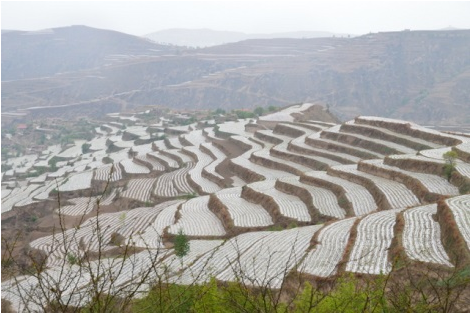By Susan Beccio
![]()
Women, who buy fish wholesale and sell in the local market, received training on fish handling - though not all of the practises have been easily adopted. Maria Roni, 56, secretary of the Kayakumari fish society explains that though “the women know better, they mix the fresh fish with sand because then people think it is fresh, if they put ice, people think the fish is frozen."
Beyond fish and fishing, the project also helped the most vulnerable members of the coastal communities develop skills and start small businesses to generate household income. In the next photo blogpost, I will share some of these stories.
A coastline household in Kurumpanai village, Tamil Nadu, India. This village was hit hard by the tsunami in 2004. ©IFAD/Susan Beccio
This week I visited some of the coastal areas of Tamil Nadu, India that were heavily effected by the tsunami ten years ago. Although the International Fund for Agricultural Development (IFAD) is not a relief organisation, through it's work in investing in poor rural communities, the fund provides plenty of relief to poor households. The Post-Tsunami Sustainable Livelihoods Programme for the Coastal Communities of Tamil Nadu (PTSLP) is no exception. The project has been working with people living along the coast and surrounding areas to enhance their livelihoods since 2007.

Leaders of the Kurumpanai fishermen’s group talk about the tsunami at the fishing society headquarters in Kurumpanai village, Tamil Nadu, India. ©IFAD/Susan Beccio
Though the people from this area had never experienced a tsunami before they "knew something different was happening with the sea, so they ran to the mountains", said the leaders of the Kurumpanai fishermen's group in unison. Many fishermen in the village lost their nets and boats and none of the fishermen in the area were able to work for the next five months.
Fishermen repair their nets in Kanyakumari village, Tamil Nadu, India. ©IFAD/Susan Beccio
The project provided loans to fishing groups to buy improved boats and fishermen received fishing nets, ice boxes and cutting knives. Boatyards, landing docks and wholesale fish markets were also built, and cement reefs were installed offshore to act as a buffer and protect the shoreline from erratic sea levels.
The new wholesale fish market building is near completion in Kurumpanai village, Tamil Nadu, India. ©IFAD/Susan Beccio
Traditionally, fishermen arrive with their catch and sell it to retail buyers right on the beach. The fishing groups have installed a more orderly and transparent practise of auctioning fish on the landing dock. Women retailers play an active part in bidding for fish and estimating their profits for the day.
Auctioneer hawks fish to retail buyers in Kanyakumari village, Tamil Nadu, India. ©IFAD/Susan Beccio
Women, who buy fish wholesale and sell in the local market, received training on fish handling - though not all of the practises have been easily adopted. Maria Roni, 56, secretary of the Kayakumari fish society explains that though “the women know better, they mix the fresh fish with sand because then people think it is fresh, if they put ice, people think the fish is frozen."
Women sell fish at the Erulapapuram market, 3 kilometers from the coastline. Nagercoil, Tamil Nadu, India. ©IFAD/Susan Beccio













.jpg)















































